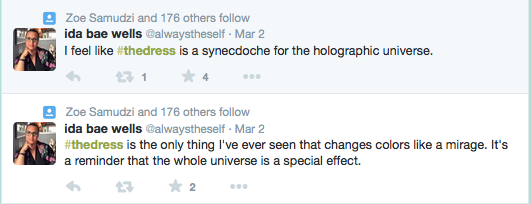Finding poetry on Twitter

For many Internet users, social media constitutes the extent of their regular textual encounters. As a result, Web 2.0 platforms are increasingly becoming spaces that facilitate expressions of imagination and the processing of human experience. Hashtags on Twitter - # and word combinations that link 140-character messages called tweets - trend regularly on the site, reflecting the most popular topics identified by the platform’s algorithm. Those who use hashtags may tweet for a range of reasons, from participating in flash-in-the-pan controversies over the color of a dress to weaponized hashtags linked to ongoing protest movements like #BlackLivesMatter. Are tweets simply expressions of the Internet's id or might we find among them some of Percy Bysshe Shelley’s “unacknowledged legislators of the world”— poets?
Darren Wershler, a Canadian poet and critic, suggests that the first place most people experience poetry is not “official channels of poetry” — like literary magazines or festivals — but through texts they encounter in the ordinary experience of browsing the Internet. Of such texts, he notes, “These artifacts aren’t conceived of as poems; they aren’t produced by people who identify as poets; they circulate promiscuously, sometimes under anonymous conditions; and they aren’t encountered by interpretive communities that identify them as literary” (Wershler).
Tweets that populate Twitter’s hashtags meet Wershler’s definition of found poetry online. Their creators are generally not intending poetic effect. Tweets move through the platform swiftly, as users share them with their own networks by clicking a “retweet” button. Most readers are not, in fact, looking for literature.
Yet, hashtags can engender aesthetic responses. Take, for example, Professor Crystal Fleming’s musings on #thedress, an Internet controversy that trended on Twitter last week as users debated whether a dress was white and gold or blue and black. She tweets, "#thedress is the only thing I've ever seen that changes colors like a mirage. It's a reminder that the whole universe is a special effect" and "I feel like #thedress is a synecdoche for the holographic universe."
Fleming, a professor of sociology and Africana studies at Stony Brook University, compares #thedress to a mirage, evoking the possibilities for seeing beyond the limits of vision. She positions not only the dress but the universe itself as an exercise in ephemerality. Considering Fleming's response through the broader frame of her other tweets, which reflect an investment in intersectional and post-intersectional feminisms, her tweets on the dress take on additional meaning in relation to questions of difference, namely the ways that identification, lived experience, and even knowledge are provisional and ever-shifting. In doing so, she transforms the quotidian fascination of social media users with a dress into extraordinary commentary on the nature of perception— 140 characters at a time.
Perhaps we can find poetry on Twitter.
**
Fleming, Crystal (alwaystheself). “#thedress is the only thing I’ve ever seen that changes colors like a mirage. It’s a reminder that the whole universe is a special effect.” 2 Mar. 2015, 11:48 p.m. Tweet. 3 Mar. 2015.
—. “I feel like #thedress is a synecdoche for the holographic universe.” 2 Mar. 2015, 11:49 p.m. Tweet. 3 Mar. 2015.
Wershler, Darren. “Best Before Date.” Alienated. 4 Apr. 2012. Web. 27 Feb. 2015.
Postcolonial digital poetics